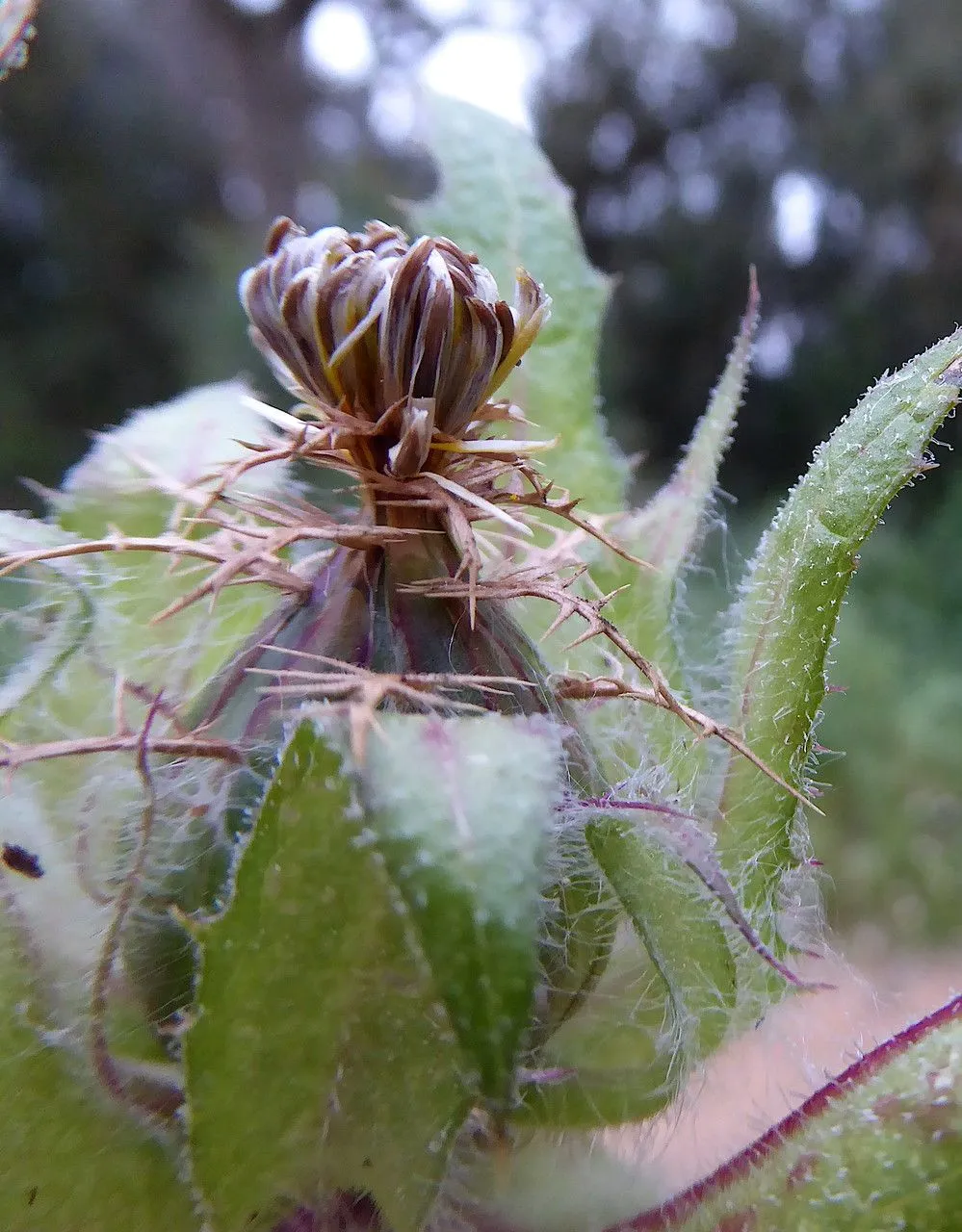
Author: (L.) L.
Bibliography: Sp. Pl., ed. 2, 2: 1296 (1763)
Year: 1763
Status: accepted
Rank: species
Genus: Centaurea
Vegetable: False
Observations: Europe to Xinjiang
Blessed thistle, known scientifically as Centaurea benedicta, holds a profound historical significance and is cherished for its therapeutic properties. Native to regions ranging from Europe to Xinjiang, this member of the Asteraceae family has been recognized and classified for centuries, with its official bibliographic reference dating back to 1763 in the seminal work “Species Plantarum”, 2nd edition.
This hardy annual herb is often revered for its distinctive attributes. Visually, blessed thistle is characterized by its spiny, lobed leaves and bright yellow flowers, which serve as a hallmark of its genus. The plant typically flourishes in dry, rocky soils, reflecting its ability to thrive in well-drained environments. Blessed thistle has historically been utilized for its medicinal qualities, particularly in traditional herbal medicine.
The primary active components in blessed thistle are cnicin and other polyacetylene compounds. These substances are believed to stimulate the secretion of gastric juices, thereby assisting in digestion. Furthermore, blessed thistle has been reputed to possess anti-inflammatory and antimicrobial properties, making it a valuable herb in treating various ailments ranging from gastrointestinal distress to respiratory infections.
In addition to its medicinal uses, blessed thistle has earned a place in herbal lore and literature. It was once thought to possess virtues akin to a “panacea,” reflecting the profound respect with which it was regarded by early herbalists. Despite modern advances in medicine, blessed thistle remains a symbol of natural healing and continues to be a subject of research and interest within the field of botany.
In sum, Centaurea benedicta stands as more than just a botanical specimen; it is a testament to the enduring relationship between humans and medicinal plants. Its widespread presence from Europe to Xinjiang underscores its adaptability and enduring significance in traditional medicine and natural healing practices.
Deu: benediktenkraut, bitterdistel, echtes benediktenkraut
Eng: blessed thistle, holy thistle, our lady’s thistle
Dan: korbendikt
Spa: cardo-bendito, cardo-blanco, cardo-santo, centaurea-bendita, cristo-pobre
Por: cardo-bento, cardo-santo
Fra: chardon bénit, chardon béni, cnicaut béni
Swe: kardbenedikt
En: Blessed thistle, Blessed thistle, Holy Thistle, Our Lady’s thistle, Blessed knapweed
Sq: Cnuku
Ar: قنطريون مبارك
Hy: Լայնատերևուկ
Az: Adi lopatikan
Eu: Txori-kardu
Ca: Card beneit
Zh: Cang ye hua, 藏掖花
Cs: Benedikt lékařský
Da: Korbenedikt, Korbendikt
Nl: Gezegende distel, Cnicus
Eo: Cnicus benedictus
Fi: Karvaskaunokki
Fr: Chardon bénit, Chardon béni, Cnicaut béni, Centaurée laineuse, Faux Safran
Gl: Cardo santo
De: Benediktenkraut, Bitterdistel, Benediktendistel, Benediktenkarde, Benediktenwurz, Bernhardinerwurzel, Bornwurz, Distelkraut, Kardobenedikte, Spinnendistel, Echtes Benediktenkraut, Acker-Schachtelhalm, Heildistel, Natternkraut
Hu: Benedekfű
It: Cardo benedetto
Kk: Арқал
Mk: Питом трн
Fa: خار مقدس
Pl: Drapacz lekarski
Pt: Cardo-bento, Cardo-santo, Cnicus
Ro: Schinel
Ru: Benedikt aptečnyj, Knikus blagoslovennyj, Кникус
Sr: Блажени чкаљ
Es: Cnicus benedictus, Cardo-bendito, Cardo-blanco, Cardo-santo, Centaurea-bendita, Cristo-pobre, Cardo bendito, Cardo benedictino, Cardo santo
Sv: Kardbenedikt, Cnicus
Tr: Şevketibostan
Uk: Кнік бенедиктинський
Taken May 29, 2014 by Tela Botanica − Liliane Roubaudi (cc-by-sa)
Taken May 29, 2014 by Tela Botanica − Liliane Roubaudi (cc-by-sa)
Taken May 29, 2014 by Tela Botanica − Liliane Roubaudi (cc-by-sa)
Taken May 6, 2018 by Llandrich anna (cc-by-sa)
Taken May 6, 2018 by Llandrich anna (cc-by-sa)
© copyright of the Board of Trustees of the Royal Botanic Gardens, Kew.
© copyright of the Board of Trustees of the Royal Botanic Gardens, Kew.
© copyright of the Board of Trustees of the Royal Botanic Gardens, Kew.
Taken May 29, 2014 by Tela Botanica − Paul FABRE (cc-by-sa)
Taken May 8, 2006 by Tela Botanica − Liliane ROUBAUDI (cc-by-sa)
Taken Apr 14, 2016 by Tela Botanica − Liliane ROUBAUDI (cc-by-sa)
Taken May 29, 2014 by Tela Botanica − Paul FABRE (cc-by-sa)
Taken May 6, 2018 by Llandrich anna (cc-by-sa)
Taken May 14, 2020 by Ángel Sánchez (cc-by-sa)
Taken May 18, 2018 by JASD (cc-by-sa)
Taken Feb 6, 2022 by Sánchez Ángel (cc-by-sa)
Taken May 2, 2020 by Colmenarejo Rodríguez Marc (cc-by-sa)
Taken May 6, 2018 by Llandrich anna (cc-by-sa)
Taken May 29, 2014 by Tela Botanica − Paul FABRE (cc-by-sa)
Taken Apr 14, 2018 by Tela Botanica − Liliane ROUBAUDI (cc-by-sa)
Taken Apr 14, 2018 by Tela Botanica − Liliane ROUBAUDI (cc-by-sa)
Taken May 8, 2006 by Tela Botanica − Liliane ROUBAUDI (cc-by-sa)
Taken May 29, 2014 by Tela Botanica − Paul FABRE (cc-by-sa)
Taken Jul 6, 2022 by pflantastisch (cc-by-sa)
Taken May 4, 2019 by m Celik (cc-by-sa)
Taken Apr 1, 2017 by Pedro Salgadinho (cc-by-sa)
Taken May 3, 2020 by Llandrich anna (cc-by-sa)
Taken Jun 2, 2021 by Llandrich anna (cc-by-sa)
Taken Apr 15, 2004 by Photoflora – Benoit BOCK (©)
Taken Apr 15, 2012 by Photoflora – Benoit BOCK (©)
Taken May 15, 2017 by Photoflora – Benoit BOCK (©)
Taken Apr 15, 2012 by Photoflora – Benoit BOCK (©)
Taken Jan 1, 1970 by Photoflora – L’Abbé COSTE (©)
Ph maximum: 7.5
Ph minimum: 7.0
Light: 8
Atmospheric humidity: 4
Soil nutriments: 6
Family: Myrtaceae Author: (F.Muell.) K.D.Hill & L.A.S.Johnson Bibliography: Telopea 6: 402 (1995) Year: 1995 Status:…
Family: Rubiaceae Author: Pierre ex A.Froehner Bibliography: Notizbl. Bot. Gart. Berlin-Dahlem 1: 237 (1897) Year:…
Family: Sapindaceae Author: Koidz. Bibliography: J. Coll. Sci. Imp. Univ. Tokyo 32(1): 38 (1911) Year:…
Family: Asteraceae Author: A.Gray Bibliography: Pacif. Railr. Rep.: 107 (1857) Year: 1857 Status: accepted Rank:…
Family: Fabaceae Author: Medik. Bibliography: Vorles. Churpfälz. Phys.-Ökon. Ges. 2: 398 (1787) Year: 1787 Status:…
Family: Aspleniaceae Author: (Cav.) Alston Bibliography: Bull. Misc. Inform. Kew 1932: 309 (1932) Year: 1932…